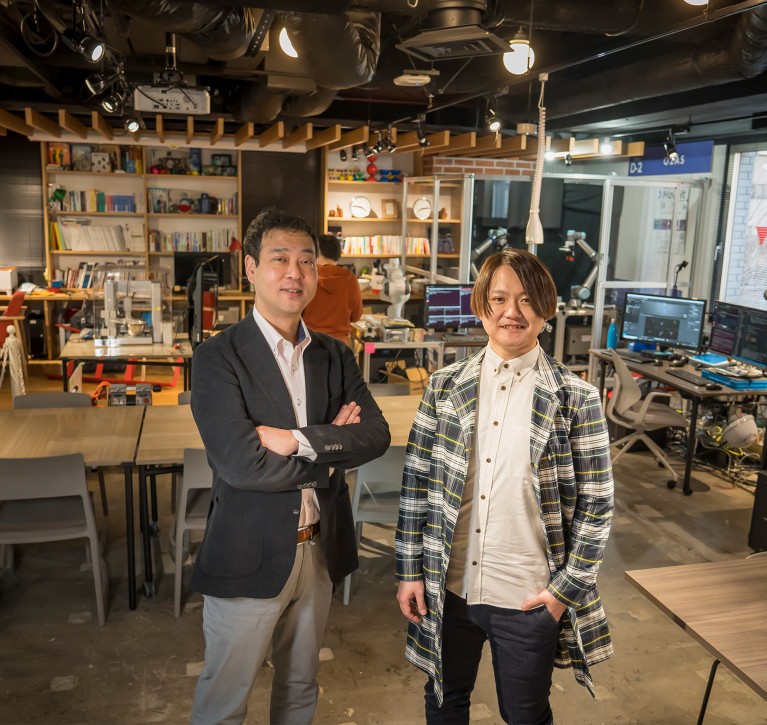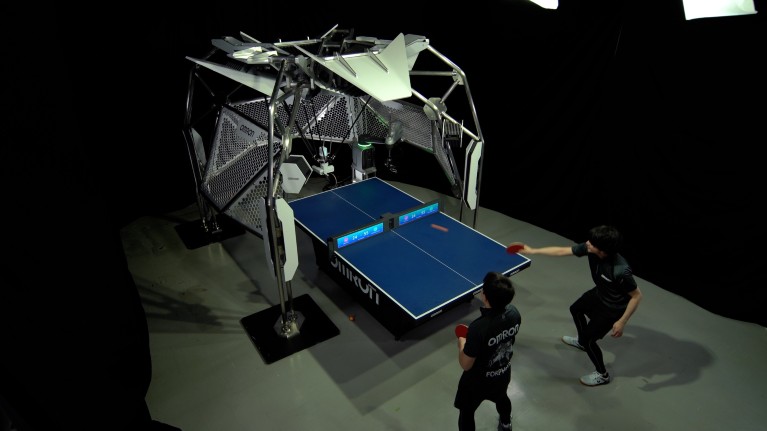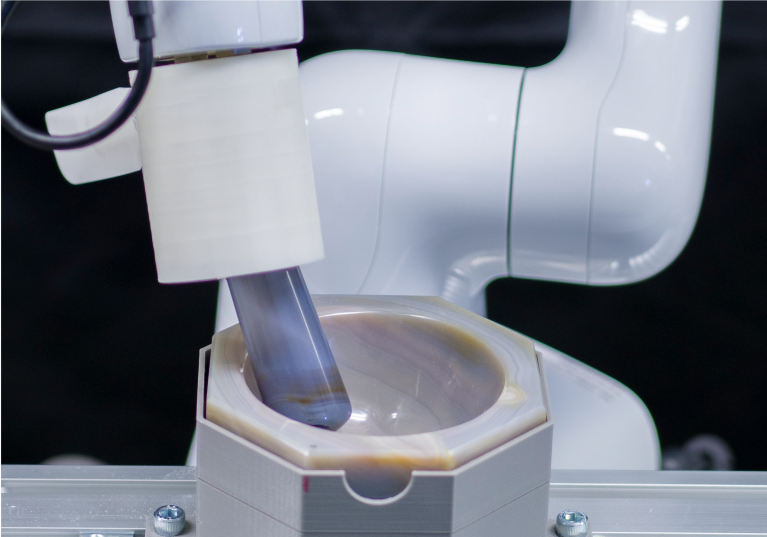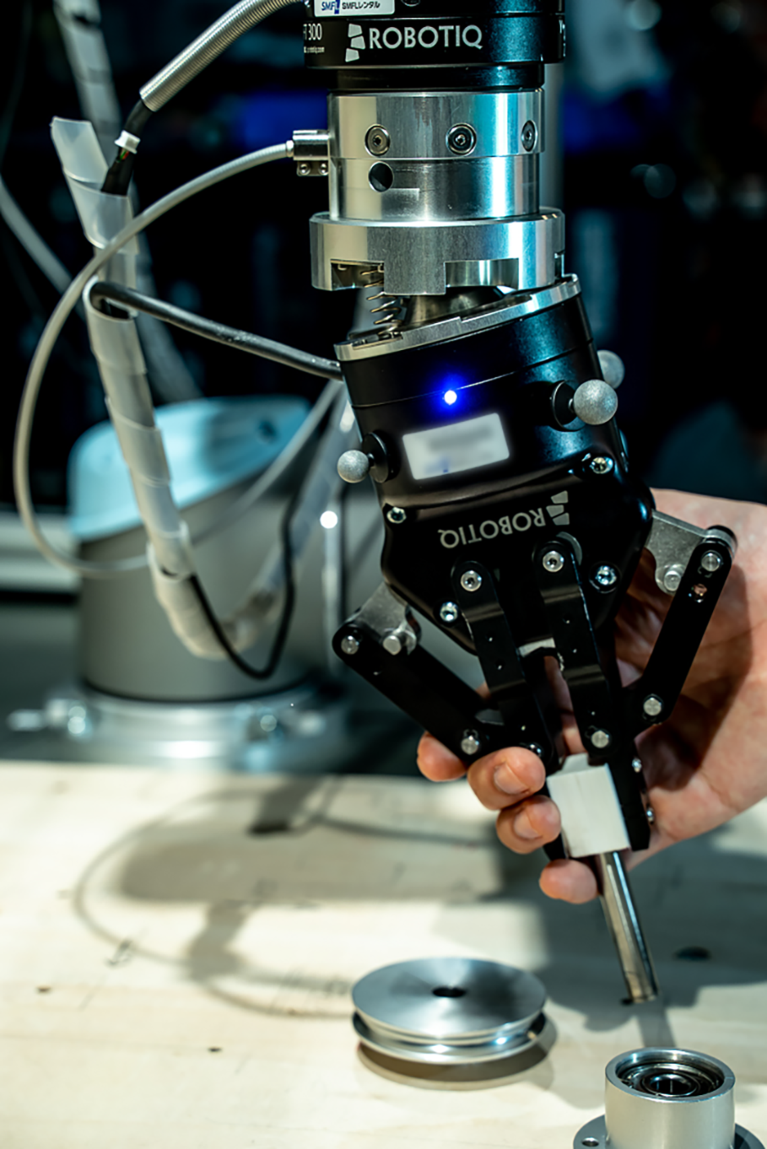
(From left to right) Masaki Suwa and Yoshitaka Ushiku are excited about the potential of AI to enhance innovation.© OMRON Corporation
More than half a century ago — well before the onset of the internet and smartphones — Kazuma Tateishi predicted the dawn of the information age. He also envisioned that it would be followed by an era of ‘optimization’ during which society will attempt to correct the negative consequences of a materialist culture.
Founder of the company OMRON, Tateishi unveiled a framework to predict future changes to society known as Seed-Innovation to Need-Impetus Cyclic Evolution (SINIC) theory in 1970. According to this theory, a self-ruling society replete with robots will emerge — one where people can both enrich society and pursue their own fulfillment.
“The enabler for that is a harmonious relationship between people and machines,” says Masaki Suwa, the chief executive officer of OMRON’s artificial intelligence (AI) and robotics research arm OMRON SINIC X (OSX) — a company spun off from OMRON to establish a research base for technology to meet social needs.
The company as a whole is conducting future-oriented research based on SINIC theory, while OSX looks specifically at innovative technologies to achieve this. Although a corporate research institute, OSX brings together people from universities, research institutes, and companies to promote research and development through open innovation.
“To achieve such a relationship, people and machines first need to be able to communicate,” Suwa says, adding that communication isn’t limited to human language.
“It’s about giving and receiving feedback in all manners, and it can include all types of programming languages, as well as the understanding of tactical feedback and facial expressions,” says Suwa. “Research themes at OSX include sensing, AI, robotics and human–machine interaction, all of which we believe will contribute to communication.”
For a harmonious human–machine future, researchers at the company are focusing on the core pillars of interpreting and learning instruction patterns from humans, moving intelligently to assist with manual labour, and perceiving the environment to interact with other AI-imbued robots and humans.

A robot that plays table tennis is just one example of a machine interacting with people.© OMRON Corporation
AI for innovation
Yoshitaka Ushiku, principal investigator at OSX, leads a project that seeks to develop AI robots that will help humans with research. “Our long-term goal is a world where humans and AI collaborate to produce Nobel Prize-level research by 2050,” he says. The project was selected for the Moonshot Research and Development Program, a Japanese government initiative that funds ambitious research projects addressing the most challenging social issues.
The idea originated from an ongoing project seeking to design AI that assists the development of novel materials, an area that demands extensive creative thinking. Ushiku likens the development of new materials to creating a recipe.
“The researchers initially choose and mix materials, and the AI learns what has led to success. With enough data, the AI can suggest modifications to the recipe. At the core, these principles should help all kinds of research,” says Ushiku. “In addition to ideation, robots loaded with AI can conduct experiments on behalf of researchers 24/7, 365 days a year, in dangerous environments such as areas with high radiation or extreme temperatures. With a group of such AI scientist robots, research labs could dramatically boost their throughput.”
For AI to become effective partners, Ushiku and collaborators believe that AI needs to gain proficiency in the four phases of research: ideation, experimentation, analysis and description. The first milestone for 2025 is to complete AI robots that can decipher research claims well enough to review papers and can replicate studies. In addition to recognizing what is written, these AIs must understand the value that the research adds and how the results relate to the hypothesis. Furthermore, AI robots assisting with experiments should be able to distinguish best practices that lead to precise outcomes.
“With increased global interest on AI that support research, technology firms and institutions are releasing AI models designed for that purpose. However, there’s a tremendous gap between the ability to write papers using manuscript-style language, and the ability to assess whether the content truly matches principles of physics and chemistry,” says Ushiku. “To write papers and to facilitate scholarly discussion, AI needs to internalize the principles underlying each academic field. It also needs to be able to demonstrate the evidence and principles it drew upon to generate suggestions. That’s a significant missing link that research in this area needs to address.”
Changing role of experts
The team hopes for AI robots to publish studies in peer-reviewed journals by 2030, and in high-impact journals by 2040. The AI robots, however, will continue to require human input to drive research even when reaching the final goal in 2050, says the scientists.

An AI-assisted robot helps to grind materials in a mortar.© OMRON Corporation
“Our project aspires to enable AI robots to communicate with human researchers so that they can receive suggestions. AI robots should provide inputs that are meaningful enough to provoke changes in action from human researchers, but they will not conclude the entire research process on their own,” says Ushiku.
The core skills for human professionals will shift towards the ability to give commands and to make judgements, adds Suwa. “We often speak of automating mundane tasks to allow people to focus on creative ideation,” he says. “We need to do a better job of demonstrating what that looks like specifically, and our proposal of giving commands and making judgements is one way to address this.”
AI for illustrations, is an example. With input from non-professionals, AI can produce artwork that uses an impressive level of technique. The artwork, however, is far from a masterpiece; the outputs are unoriginal, as AI tends to merely learn from existing art rather than employ genuine creativity.

An AI-assisted robot helps a human operator to perform peg-in-hole tasks.© OMRON Corporation
“It’s when professionals give direction on themes to include and the composition that the AI can pull elements together that make for a beautiful illustration. Knowing how to give good instructions is a skill that only experts will possess,” explains Ushiku.
Suwa stresses that AI is a vehicle for empowerment, and that dialogue should focus on how people live with AI as partners. “AI is a tool just like a pencil or a laptop, and nothing more. The concern should not be so much about AI against humans, but about empowering humans to understand how AI works,” says Suwa. “In an age when technology evolves in discontinuous leaps, we need to keep sight of how we want the future to look. Only then can we determine which technologies to develop to realize psychological satisfaction.”



 Nature Index Japan 2023
Nature Index Japan 2023